2013.5 Peugeot 308 CC dashboard
[x] Cancel search: dashboardPage 29 of 268
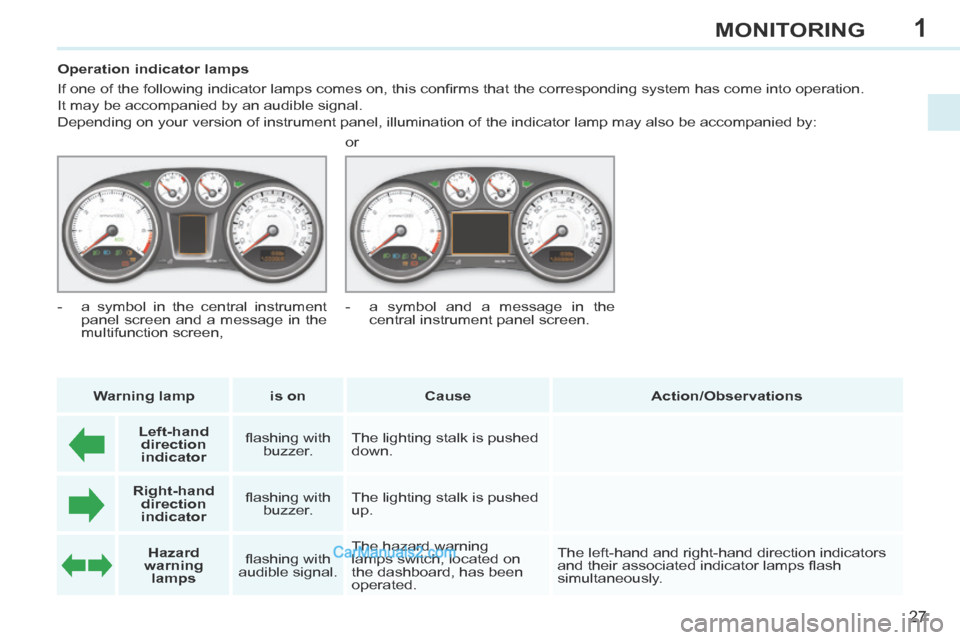
1
27
MONITORING
Operation indicator lamps
If one of the following indicator lamps comes on, this confi rms that the corresponding system has come into operation.
It may be accompanied by an audible signal.
Depending on your version of instrument panel, illumination of the indic\
ator lamp may also be accompanied by: Warning lamp is on Cause Action/Observations
Left-hand
direction
indicato r fl ashing with
buzzer. The lighting stalk is pushed
down.
Right-hand
direction
indicator fl ashing with
buzzer. The lighting stalk is pushed
up.
Hazard
warning lamps fl ashing with
audible signal. The hazard warning
lamps switch, located on
the dashboard, has been
operated. The left-hand and right-hand direction indicators
and their associated indicator lamps fl ash
simultaneously.
- a symbol in the central instrument
panel screen and a message in the
multifunction screen, or
- a symbol and a message in the
central instrument panel screen.
Page 31 of 268
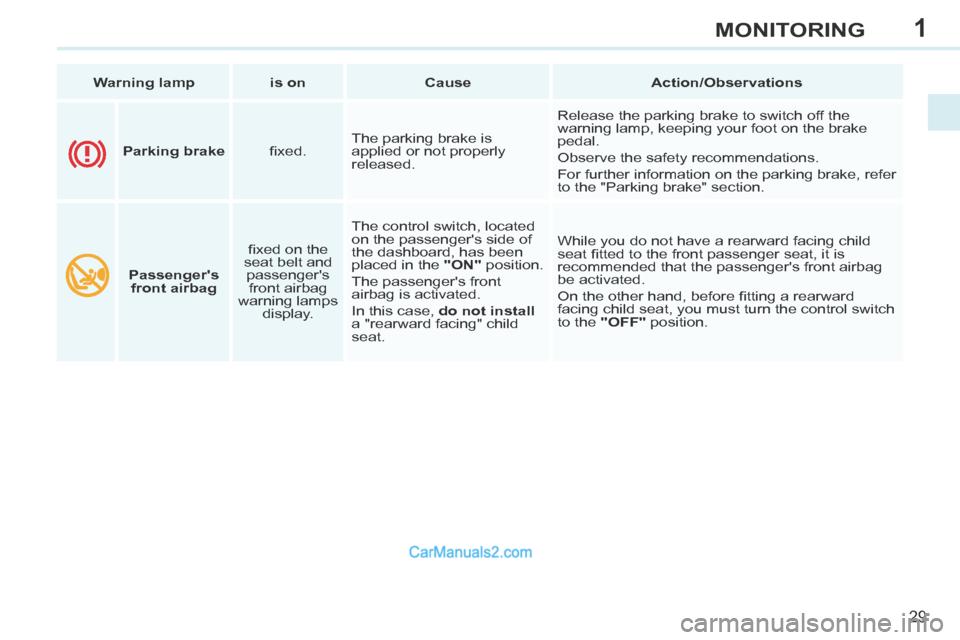
1
29
MONITORING
Warning lamp is on Cause Action/Observations
Passenger's
front airbag fi xed on the
seat belt and passenger's front airbag
warning lamps display. The control switch, located
on the passenger's side of
the dashboard, has been
placed in the
"ON" position.
The passenger's front
airbag is activated.
In this case, do not install
a "rearward facing" child
seat. While you do not have a rearward facing child
seat fi tted to the front passenger seat, it is
recommended that the passenger's front airbag
be activated.
On the other hand, before fi tting a rearward
facing child seat, you must turn the control switch
to the
"OFF" position.
Parking brake fi xed. The parking brake is
applied or not properly
released. Release the parking brake to switch off the
warning lamp, keeping your foot on the brake
pedal.
Observe the safety recommendations.
For further information on the parking brake, refer
to the "Parking brake" section.
Page 32 of 268
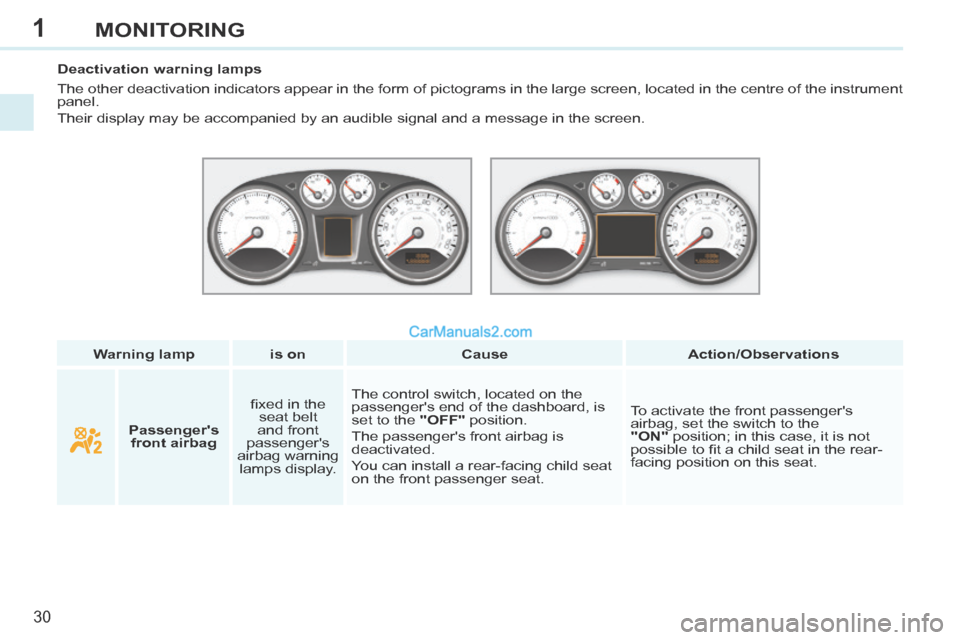
1
30
MONITORING
Warning lamp is on Cause Action/Observations
Deactivation warning lamps
The other deactivation indicators appear in the form of pictograms in th\
e large screen, located in the centre of the instrument
panel.
Their display may be accompanied by an audible signal and a message in t\
he screen.
Passenger's
front airbag fi xed in the
seat belt
and front
passenger's
airbag warning lamps display. The control switch, located on the
passenger's end of the dashboard, is
set to the
"OFF" position.
The passenger's front airbag is
deactivated.
You can install a rear-facing child seat
on the front passenger seat. To activate the front passenger's
airbag, set the switch to the
"ON" position; in this case, it is not
possible to fi t a child seat in the rear-
facing position on this seat.
Page 48 of 268
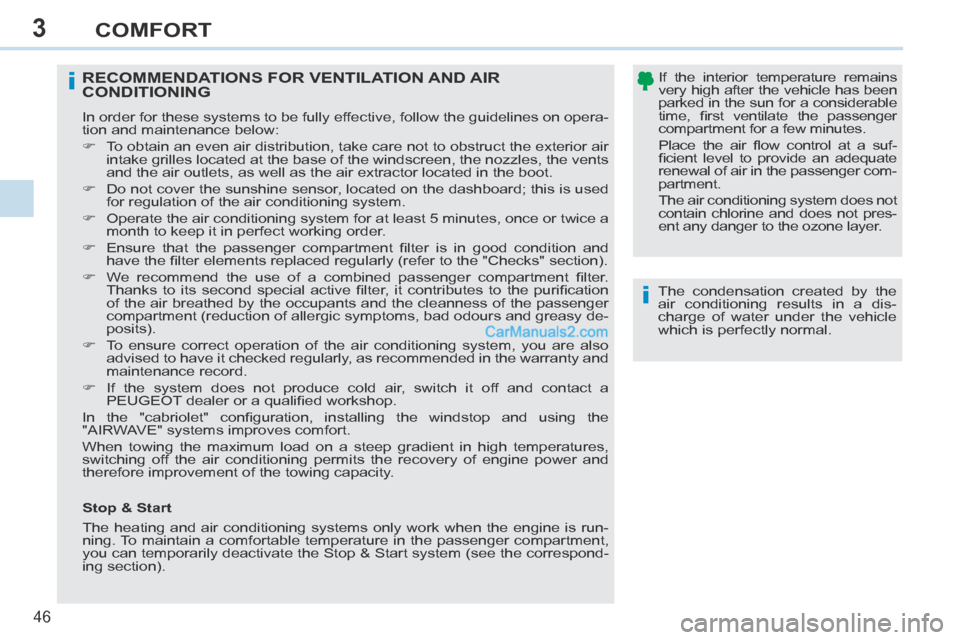
3
i
i
46
COMFORT
The condensation created by the
air conditioning results in a dis-
charge of water under the vehicle
which is perfectly normal.
RECOMMENDATIONS FOR VENTILATION AND AIR CONDITIONING
In order for these systems to be fully effective, follow the guidelines on opera-
tion and maintenance below:
To obtain an even air distribution, take care not to obstruct the exterio\
r air intake grilles located at the base of the windscreen, the nozzles, the v\
ents
and the air outlets, as well as the air extractor located in the boot.
Do not cover the sunshine sensor, located on the dashboard; this is used for regulation of the air conditioning system.
Operate the air conditioning system for at least 5 minutes, once or twic\
e a month to keep it in perfect working order.
Ensure that the passenger compartment fi lter is in good condition and have the fi lter elements replaced regularly (refer to the "Checks" section).
We recommend the use of a combined passenger compartment fi lter. Thanks to its second special active fi lter, it contributes to the purifi cation
of the air breathed by the occupants and the cleanness of the passenger \
compartment (reduction of allergic symptoms, bad odours and greasy de-
posits).
To ensure correct operation of the air conditioning system, you are also \
advised to have it checked regularly, as recommended in the warranty and
maintenance record.
If the system does not produce cold air, switch it off and contact a PEUGEOT dealer or a qualifi ed workshop.
In the "cabriolet" confi guration, installing the windstop and using the
"AIRWAVE" systems improves comfort.
When towing the maximum load on a steep gradient in high temperatures,
switching off the air conditioning permits the recovery of engine power and
therefore improvement of the towing capacity. If the interior temperature remains
very high after the vehicle has been
parked in the sun for a considerable
time, fi rst ventilate the passenger
compartment for a few minutes.
Place the air fl ow control at a suf-
fi cient level to provide an adequate
renewal of air in the passenger com-
partment.
The air conditioning system does not
contain chlorine and does not pres-
ent any danger to the ozone layer.
Stop & Start
The heating and air conditioning systems only work when the engine is ru\
n-
ning. To maintain a comfortable temperature in the passenger compartment,
you can temporarily deactivate the Stop & Start system (see the corresp\
ond-
ing section).
Page 89 of 268

6
87
FITTINGS
LOCKABLE AND COOLED GLOVE BOX
Its lid has areas for storing a pen, a pair
of spectacles, tokens, cards, a can...
It is also locked or unlocked when the
vehicle is locked or unlocked using the
remote control or the key.
To open the glove box, raise the handle.
It is illuminated when the lid is opened.
The glove box is fi tted with an air vent A ,
which can be opened or closed. This
distributes the same cooled air as the
vents in the passenger compartment.
The glove box also gives access to
the dashboard fusebox (refer to the
"Practical information - Changing a
fuse" section).
SUN VISOR
Component which protects against sunlight
from the front or the side, also equipped with
an illuminated courtesy mirror.
With the ignition on, raise the con- cealing fl ap; the mirror is lit automati-
cally.
This sun visor is also equipped with a
ticket holder.
Page 97 of 268
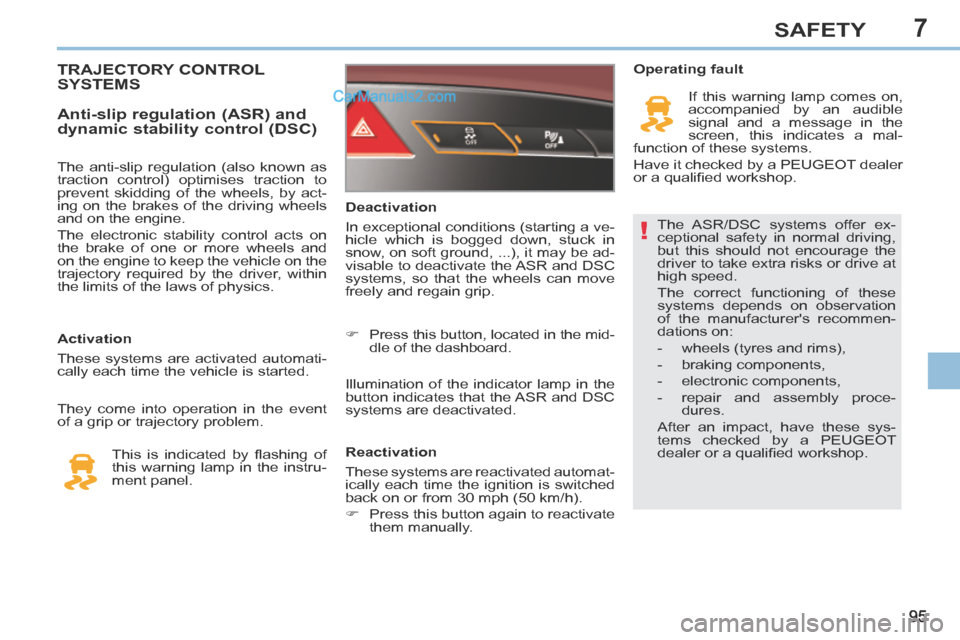
7
!
95
SAFETY
The ASR/DSC systems offer ex-
ceptional safety in normal driving,
but this should not encourage the
driver to take extra risks or drive at
high speed.
The correct functioning of these
systems depends on observation
of the manufacturer's recommen-
dations on:
- wheels (tyres and rims),
- braking components,
- electronic components,
- repair and assembly proce-dures.
After an impact, have these sys-
tems checked by a PEUGEOT
dealer or a qualifi ed workshop.
Deactivation
In exceptional conditions (starting a ve-
hicle which is bogged down, stuck in
snow, on soft ground, ...), it may be ad-
visable to deactivate the ASR and DSC
systems, so that the wheels can move
freely and regain grip.
Press this button, located in the mid- dle of the dashboard.
Illumination of the indicator lamp in the
button indicates that the ASR and DSC
systems are deactivated.
Reactivation
These systems are reactivated automat-
ically each time the ignition is switched
back on or from 30 mph (50 km/h).
Press this button again to reactivate them manually. Operating fault
If this warning lamp comes on,
accompanied by an audible
signal and a message in the
screen, this indicates a mal-
function of these systems.
Have it checked by a PEUGEOT dealer
or a qualifi ed workshop.
TRAJECTORY CONTROL SYSTEMS
Activation
These systems are activated automati-
cally each time the vehicle is started.
Anti-slip regulation (ASR) and
dynamic stability control (DSC)
They come into operation in the event
of a grip or trajectory problem.
This is indicated by fl ashing of
this warning lamp in the instru-
ment panel.
The anti-slip regulation (also known as
traction control) optimises traction to
prevent skidding of the wheels, by act-
ing on the brakes of the driving wheels
and on the engine.
The electronic stability control acts on
the brake of one or more wheels and
on the engine to keep the vehicle on the
trajectory required by the driver, within
the limits of the laws of physics.
Page 102 of 268
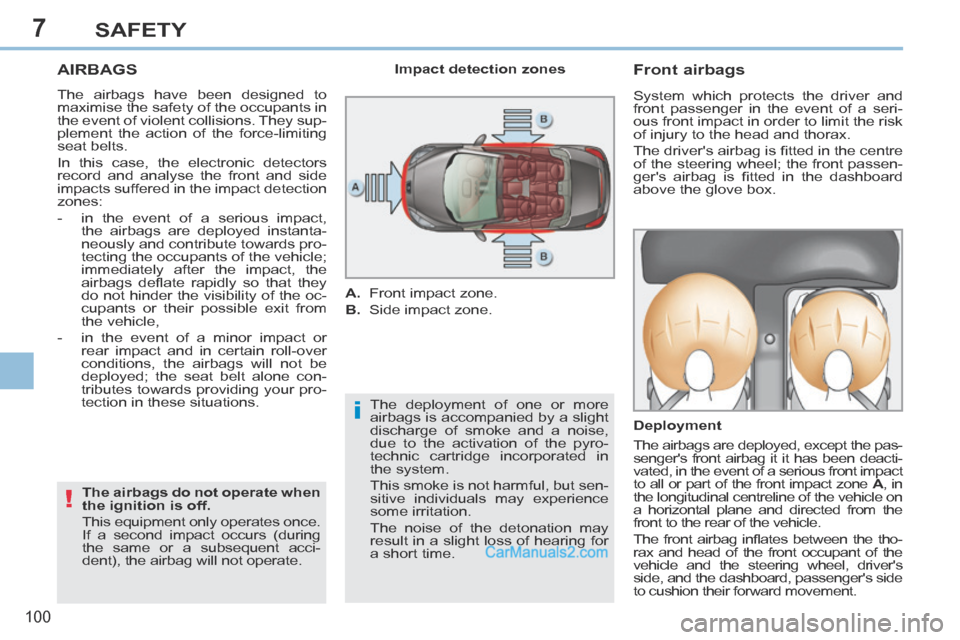
7
i
!
100
SAFETY
AIRBAGS
The airbags have been designed to
maximise the safety of the occupants in
the event of violent collisions. They sup-
plement the action of the force-limiting
seat belts.
In this case, the electronic detectors
record and analyse the front and side
impacts suffered in the impact detection
zones:
- in the event of a serious impact, the airbags are deployed instanta-
neously and contribute towards pro-
tecting the occupants of the vehicle;
immediately after the impact, the
airbags defl ate rapidly so that they
do not hinder the visibility of the oc-
cupants or their possible exit from
the vehicle,
- in the event of a minor impact or rear impact and in certain roll-over
conditions, the airbags will not be
deployed; the seat belt alone con-
tributes towards providing your pro-
tection in these situations. The deployment of one or more
airbags is accompanied by a slight
discharge of smoke and a noise,
due to the activation of the pyro-
technic cartridge incorporated in
the system.
This smoke is not harmful, but sen-
sitive individuals may experience
some irritation.
The noise of the detonation may
result in a slight loss of hearing for
a short time.
Front airbags
Deployment
The airbags are deployed, except the pas-
senger's front airbag it it has been deacti-
vated, in the event of a serious front impact
to all or part of the front impact zone A , in
the longitudinal centreline of the vehicle on
a horizontal plane and directed from the
front to the rear of the vehicle.
The front airbag infl ates between the tho-
rax and head of the front occupant of the
vehicle and the steering wheel, driver's
side, and the dashboard, passenger's side
to cushion their forward movement.
Impact detection zones
A. Front impact zone.
B. Side impact zone.
The airbags do not operate when
the ignition is off.
This equipment only operates once.
If a second impact occurs (during
the same or a subsequent acci-
dent), the airbag will not operate. System which protects the driver and
front passenger in the event of a seri-
ous front impact in order to limit the risk
of injury to the head and thorax.
The driver's airbag is fi tted in the centre
of the steering wheel; the front passen-
ger's airbag is fi tted in the dashboard
above the glove box.
Page 105 of 268
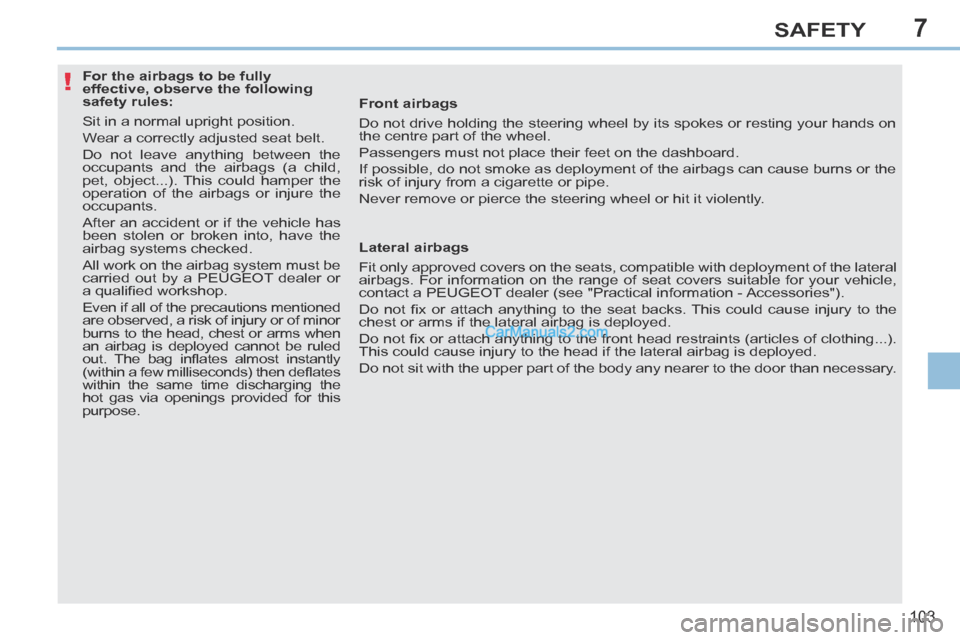
7
!
103
SAFETY
For the airbags to be fully
effective, observe the following
safety rules:
Sit in a normal upright position.
Wear a correctly adjusted seat belt.
Do not leave anything between the
occupants and the airbags (a child,
pet, object...). This could hamper the
operation of the airbags or injure the
occupants.
After an accident or if the vehicle has
been stolen or broken into, have the
airbag systems checked.
All work on the airbag system must be
carried out by a PEUGEOT dealer or
a qualifi ed workshop.
Even if all of the precautions mentioned
are observed, a risk of injury or of minor
burns to the head, chest or arms when
an airbag is deployed cannot be ruled
out. The bag infl ates almost instantly
(within a few milliseconds) then defl ates
within the same time discharging the
hot gas via openings provided for this
purpose. Front airbags
Do not drive holding the steering wheel by its spokes or resting your ha\
nds on
the centre part of the wheel.
Passengers must not place their feet on the dashboard.
If possible, do not smoke as deployment of the airbags can cause burns or the
risk of injury from a cigarette or pipe.
Never remove or pierce the steering wheel or hit it violently.
Lateral airbags
Fit only approved covers on the seats, compatible with deployment of the\
lateral
airbags. For information on the range of seat covers suitable for your vehicle,
contact a PEUGEOT dealer (see "Practical information - Accessories").
Do not fi x or attach anything to the seat backs. This could cause injury to the
chest or arms if the lateral airbag is deployed.
Do not fi x or attach anything to the front head restraints (articles of clothing...).
This could cause injury to the head if the lateral airbag is deployed.
Do not sit with the upper part of the body any nearer to the door than necessary.